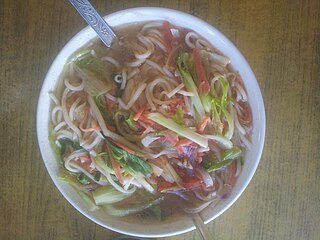
Corn soup is a soup made of corn, typically sweetcorn. Initially popular only in corn-producing areas of the world, the dish is now widespread because of greater corn distribution. Typical ingredients are corn cut from the cob, water, butter and flour, with salt and pepper for seasoning. Additional ingredients vary by region, and may include eggs.

South Asian cuisine, includes the traditional cuisines from the modern-day South Asian republics of Bangladesh, India, Maldives, Nepal, Pakistan and Sri Lanka, also sometimes including the kingdom of Bhutan and the emirate of Afghanistan. Also sometimes known as Desi cuisine, it has been influenced by and also has influenced other Asian cuisines beyond the Indian subcontinent.

Thukpa is a Tibetan noodle soup, which originated in the eastern part of Tibet. Amdo thukpa, especially thenthuk, is a variant among the Indians, especially Ladakhis and the Sikkimese. Thukpa can be prepared in both vegetarian and non-vegetarian variations; the most popular non-vegetarian variation includes chicken.

Kesme or erişte is a type of egg noodle found in various Central Asian countries. It is also found in Turkish cuisine and is called erişte and “kesme” in modern standard Turkish. The word itself is a nominalisation of the verb to cut or to slice, referring to the slicing of the dough involved in preparing the noodles. The term may refer to the noodles themselves, or the prepared dish made with them. Kesme is traditionally a homemade dish, and not often found at restaurants or cafés. In Turkey, kesme is also known as "erişte", and eaten generally in winter. It is made from flour, egg, water, salt and milk. These ingredients are worked into a dough, which is rolled out, cut, and dried in the sun or an oven after dried for a day.

Cheese soup is a type of soup prepared using cheese as a primary ingredient, along with milk, broth and/or stock to form its basis. Various additional ingredients are used in its preparation, and various types and styles of cheese soup exist. It is a part of some cuisines in the world, such as American, Colombian, Mexican, Swiss, French, and Tibetan cuisines. Mass-produced cheese soups may be prepared with the addition of food additives to preserve them and enhance flavor. A list of cheese soups is included in this article.
In Tibetan cuisine, Zhoixo is a dish made with wild ginseng and yogurt.

Shabhalep, also known as sha phaley, is a Tibetan dish of bread stuffed with seasoned meat and cabbage, which is then fashioned into semi-circular or circular shapes and which according to regional variations is either deep fried or pan fried like pot stickers.

Tingmo is a steamed bread in Tibetan cuisine. It is sometimes described as a steamed bun that is similar to Chinese flower rolls, with a soft and fluffy texture. It does not contain any kind of filling. A tingmo with some type of filling, like beef or chicken, is called a momo. Tingmo are often paired with vegetable dishes, meat dishes, dal dishes, and phing sha. It is speculated that the name "tingmo" is a contraction of "tinga" and "momo".
Sha Shingbee is a stir-fry dish of sliced mutton with green beans in Tibetan cuisine.

Guthuk is a stew soup in Sherpa or Tibetan cuisine, made with various ingredients like beans, vegetables, meat, or left over harvested grains. It is eaten two days before Losar, the Bot or Tibetan New Year and is a variation on thukpa bhatuk. The Tibetan religious ceremony Gutor (དགུ་གཏོར), literally meaning 'offering of the 29th', is held on the 29th of the 12th Bot or Tibetan month, and is focused on driving out all negativity, including evil spirits and misfortunes of the past year, and starting the new year in a peaceful and auspicious way. It is made with barley and other ingredients.

Thukpa bhatuk is a common Tibetan cuisine noodle soup that includes small bhatsa noodles. This dish is a common soup made in the winter but is especially important for Tibetan New Year. On Nyi-Shu-Gu, the eve of Losar, the common Tibetan soup, thukpa bhatuk is made with special ingredients to form guthuk. Guthuk is then eaten on Losar to symbolise getting rid of negativities of the past year and invite positives into the new year.








